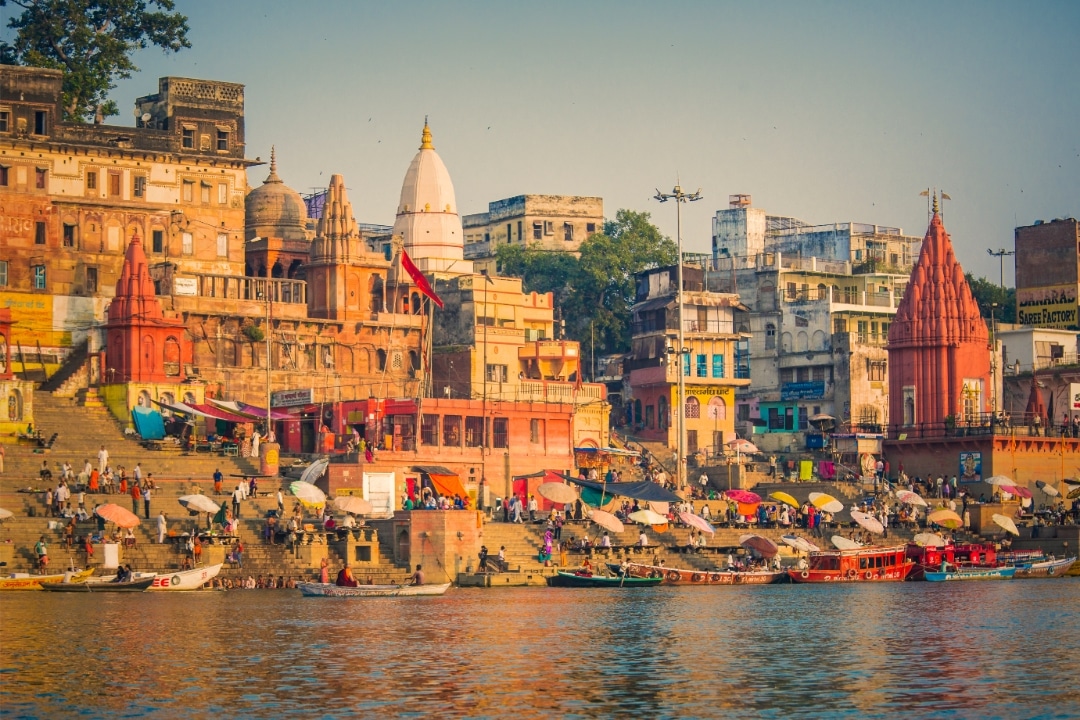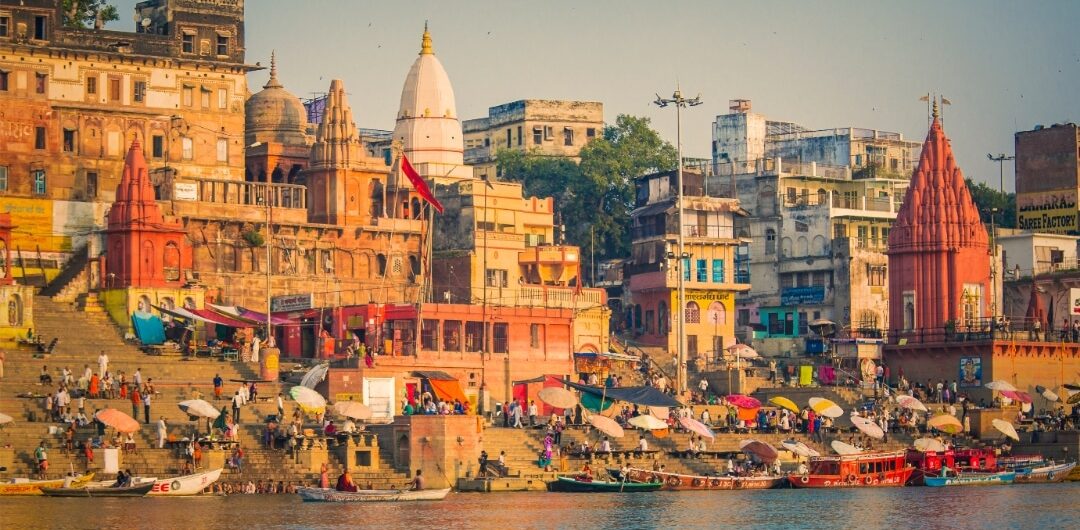Overview of 10 Must-Visit Ghats
The ancient Must-Visit Ghats that line the holy Ganges River are a well-known feature of Varanasi, the spiritual center of India. These Must-Visit Ghats are the focal point of the city because of their deep spiritual significance and rich cultural legacy. Travelers visit Varanasi to experience its timeless energy, pilgrims come to carry out rituals, and devotees take spiritual baths in the Ganges. The Must-Visit Ghats for anyone hoping to capture the essence of the city. This article discusses the Top 10 Must-Visit Ghats in Varanasi That Should Be on Every Traveler’s Itinerary.

India’s spiritual capital, Varanasi, is well-known for the historic ghats that border the sacred Ganges River. With their rich cultural heritage and spiritual significance, these ghats serve as the city’s central hub. Tourists come to Varanasi to feel its timeless energy, pilgrims come to perform rituals, and devotees bathe in the Ganges for spiritual purposes. Anyone who wants to get a sense of the spirit of the city must visit the ghats. The Top 10 Must-Visit Ghats in Varanasi that Should Be on Every Traveler’s Itinerary are discussed in this article.
1. Dashashwamedh Ghat: Varanasi’s Main Ghat
Why Take a Trip to Dashashwamedh Ghat?
In Varanasi, Dashashwamedh Ghat is the most well-known and colorful ghat. According to legend, Lord Brahma carried out a ceremony here, offering ten horses as sacrifices to welcome Lord Shiva. The Ganga Aarti, a daily evening ritual that draws sizable crowds, is the reason the ghat is so famous. A captivating ambiance is created when priests perform the aarti, waving oil lamps in time with sacred chants. It’s the ideal location for absorbing Varanasi’s spiritual energy.
What to Expect: Ganga Aarti at sunset on an evening
Observant pilgrims in holy dips
A vibrant, busy environment
2. Assi Ghat: A Calm Beginning to the Day
The Ghat at the Southernmost Point
Assi Ghat, which is located at Varanasi’s southernmost point, is a calmer, less congested area than Dashashwamedh Ghat. This location, where the Assi River joins the Ganges, is sacred because it is thought that Lord Shiva took a nap here after vanquishing demons. Locals love Assi Ghat for its peaceful atmosphere and early morning aarti. You won’t soon forget the experience of sipping a cup of chai and watching the sunrise here.
What Makes Assi Ghat Unique
calm mornings spent doing yoga
Gorgeous views at sunrise
a combination of foreign and local guests
3. The Cremation Ghat, or Manikarnika Ghat
The Moksha Gateway
One of the most sacred and ancient ghats in Varanasi is Manikarnika Ghat. Here, Hindus believe that cremation can result in moksha, or freedom from the cycle of rebirth. Although going to this ghat can be a powerful experience, it provides a deep insight into the Hindu concept of the cycle of life and death. An essential component of Varanasi’s spiritual fabric are the ongoing burning pyres and the age-old rituals carried out here.
Important Information
The main purpose of Manikarnika Ghat is cremation.
For Hindus, it is a sacred site rather than a tourist destination.
Since photography disrespects the rituals, it is generally discouraged.
4. Another Sacred Cremation Ghat is Harishchandra Ghat.
An Unknown Cremation Location
Another significant cremation site in Varanasi is called Harishchandra Ghat, after the mythical King Harishchandra, who was renowned for his loyalty and honesty. Being cremated here is thought to aid in the soul’s salvation. Though not as well-known as Manikarnika Ghat, it is nonetheless very important from a religious standpoint and provides a more serene environment for travelers wishing to experience Varanasi’s spiritual side.
Reasons to Go to Harishchandra Ghat
A more sedate substitute for Manikarnika Ghat
firmly anchored in history and mythology
5. Kedar Ghat: For Entirement in Spirit
Kedar Ghat’s Holy Waters
Adjacent to the Kashi Vishwanath Temple, Kedar Ghat is renowned for its association with South India and honors Lord Shiva, who is revered as Kedarnath in this location. Pilgrims often visit this ghat to dip in its sacred waters, which are supposed to heal skin ailments. The ghat’s unique red-and-white-striped temple contributes to its allure. Anyone looking for a more sedate spiritual experience in Varanasi should definitely visit.
Important Aspects of Kedar Ghat
A more sedate location for holy dips
strong ties to Kedarnath and Lord Shiva
A vivid red and white temple building
6. Scindia Ghat: A Secret Treasure
The Temple That’s Partially Submerged
One of Varanasi’s less well-known but no less gorgeous ghats is Scindia Ghat. It bears the Scindia family name, and the weight of an old Shiva temple here has caused a portion of the ghat to sink into the river. Photographers and those seeking solitude away from the throng love Scindia Ghat because of the semi-submerged temple’s ethereal and mystical aura.
Why Is Scindia Ghat Different?
An old temple that is partially submerged
calm and less packed
Excellent for those who love to take pictures
7. Lalita Ghat: The Link with Nepal
Nepali Flavors in Varanasi
The Nepali Temple, constructed in the 19th century by the King of Nepal and devoted to Lord Shiva in the pagoda style, is the main attraction at Lalita Ghat. The temple is distinguished from the other buildings along the ghats by its distinctive architecture and fine wood carvings. Lalita Ghat provides a serene and attractive location to relax by the river and take in Varanasi’s tranquility.
The Attractions of Lalita Ghat: Authentic Nepalese Architecture
A tranquil diversion from the bustling ghats
The Nepali Temple’s intriguing wood carvings
8. Tulsi Ghat: The Center of Cultural Activities
Inspired by Tulsidas
The well-known poet Tulsidas, who wrote the Hindu epic Ramcharitmanas here, is honored by the name Tulsi Ghat. In addition to being a site of worship, this ghat serves as a focal point for cultural events, such as Ram Leela performances, which depict the life of Lord Ram. Though it is comparatively quiet, the ghat is vital to Varanasi’s literary and cultural legacy.
Tulsi Ghat’s highlights
The location of festivals and cultural performances
a serene location with historical significance
An excellent location for book and poetry lovers
9. Darbhanga Ghat: An opulent experience and a royal legacy
Named after the Darbhanga royal family, who constructed a palace here, Darbhanga Ghat is among the most beautiful ghats in Varanasi in terms of architecture. The ghat exudes an air of nobility thanks to its magnificent palace and the stone steps that descend to the river. The palace is now a five-star hotel, providing guests with a once-in-a-lifetime chance to stay at a historically significant building while taking in the Ganges ambience.
The Reasons Darbhanga Ghat Is Unique
Magnificent building design and regal past
Today, the opulent palace is a five-star hotel.
Gorgeous vistas of the Ganges
10. Panchganga Ghat: Five Rivers Coming Together
A Hallowed Gathering Place
Panchganga Ghat is thought to be the meeting point of the Ganges, Yamuna, Saraswati, Kirana, and Dhutapapa, five sacred rivers. Even though today only the Ganges is visible, the ghat is very significant spiritually. This main ghat has a more serene atmosphere than some of the others, which makes it a tranquil spot for introspection and meditation.
Causes for Traveling to Panchganga Ghat
a calm, less crowded environment
profound spiritual significance because of the rivers’ confluence
Perfect for introspection and meditation
In summary
More than just a set of steps leading to the river, Varanasi’s ghats serve as windows into the spiritual and cultural heart of India. Every ghat possesses a unique narrative, significance, and ambience. Whether you visit these holy locations to take in the serene sunrise at Assi Ghat or the busy rituals at Dashashwamedh Ghat, you will come away with a greater appreciation of Varanasi’s enduring charm. To ensure an incredible experience while visiting one of the oldest and holiest cities in the world, be sure to incorporate these Top 10 Must-Visit Ghats into your itinerary.
FAQs
When is the best time to go to Varanasi’s Must-Visit Ghats?
For a peaceful visit, early in the morning or during the evening aarti are the ideal times to go.
Are boat trips along the Must-Visit Ghats offered?
Indeed, taking a boat ride is a common way to see the ghats, particularly at dawn or dusk.
Are photos permitted at the Must-Visit Ghats?
Although taking pictures is permitted, remember to show respect, particularly at cremation ghats such as Manikarnika and Harishchandra.
Which ghat suits the Ganga Aarti the best?
The ideal location to see the magnificent Ganga Aarti in the evening is Dashashwamedh Ghat.
Is it permissible for me to bathe in the Ganges at the Must-Visit Ghats?
Yes, the majority of ghats—particularly Dashashwamedh and Assi Ghat—are accessible for holy dips.
When Is the Best Time to Visit the Must-Visit Ghats in Varanasi?
Early in the morning or during the evening aarti are the best times to visit if you want a quiet experience.
Are there boat trips available along the Must-Visit Ghats?
In fact, seeing the ghats by boat is a popular activity, especially in the morning and evening.
Are photos permitted at the Must-Visit Ghats?
While taking photos is allowed, always remember to be respectful, especially at cremation ghats like Manikarnika and Harishchandra.
Which Must-Visit Ghats is most appropriate for the Ganga Aarti?
Dashashwamedh Ghat is the best place to witness the magnificent Ganga Aarti in the evening.
Is it okay if I take a bath at the Must-Visit Ghats in the Ganges?
Yes, you can take holy dips at most ghats, especially Dashashwamedh and Assi Ghat.


Comments